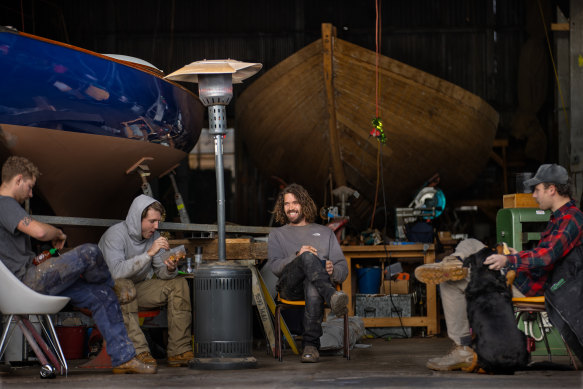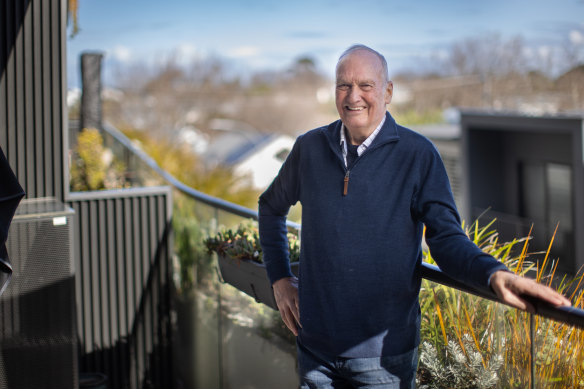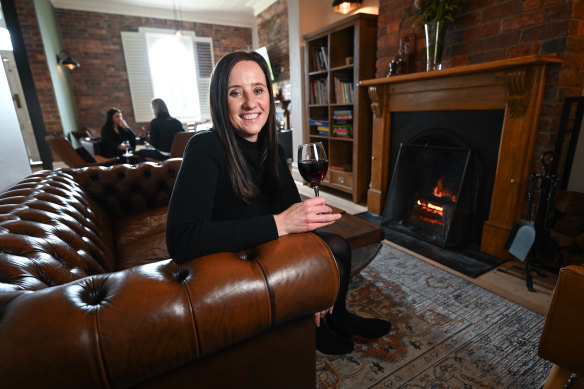Williamstown is Melbourne’s ‘country town’ seaside suburb looking over to the CBD
I’m standing with Williamstown barista Scott Kilmartin looking out over what we both agree is one of the most dramatic and contrasting panoramas in Melbourne.
The sun is thawing out a painfully cold winter morning on the waterfront.
Smoke curls out of the solitary smoke stack at the Newport power station backgrounded by the great, proud span of the West Gate Bridge. Half a dozen enormous cargo ships sit beneath the strange, alien-like container cranes.
The shimmering blue Hobsons Bay stretches to the soaring CBD skyline. Hundreds of tidy yachts rock gently at anchor in front of brutalist public housing towers.
Puffer jacket-clad retired couples walk spindly dogs along the water’s edge, in view of multimillion dollar mansions along the winding coastal road called ‘The Strand’. Nearby, a gigantic 250-metre oil tanker sits moored at Gellibrand Pier, bringing in fuel to the Mobil Altona refinery.
“Some mornings over here, it literally feels like [film director] James Cameron’s gonna walk over and go ‘cut’,” Kilmartin muses, looking out from his water-side coffee van which serves pre-dawn brews to dog walkers, fishermen, tugboat drivers, and medical on shift work at the western hospitals.
“There’s clouds and fog. The container ships are like ghost ships that move in between. It literally feels like it could be CGI [computer-generated imagery]. It’s gorgeous.”
There’s nowhere else in Melbourne quite like the western peninsula suburb of ‘Willy’; which draws in visitors from across the city for a dose of the seaside air.
‘Willy Beach’ is a go-to for thousands in the summer months. The waterfront is a favourite vantage spot for ship spotters to see cargo move in and out of the Port of Melbourne, and for tourists ferrying from the CBD to explore the bluestone history of Williamstown’s rich past.
People lucky enough to live there know they are on a good wicket.
In a week of conversations with locals The Age heard the historic seaside suburb (briefly considered as the original location for central Melbourne), described as ‘Hawthorn in the West’, similar to Manly in Sydney and Fremantle in Perth or, colourfully, “if Brighton and Daylesford has a baby”.
But every single person spoken to by The Age unprompted gave one similar descriptor; that this place “is like a country town” despite being 13 kilometres from the CBD. A place where old-timers from its industrial heyday live beside sports stars, politicians, professionals and young families.
“You’ve got a suburb with water on three sides and no through traffic – it’s like a cul de sac,” says former Labor premier Steve Bracks, who moved his family to Williamstown 34 years ago from Ballarat. Williamstown has three train stations on the Williamstown line, ferries from the CBD and St Kilda and notoriously no sets of traffic lights.
There are just over 14,000 people in the Williamstown and Williamstown North area – an “elbow” of a suburb that juts out into Port Phillip Bay, abutted by Newport to the north and Altona-Seaholme to the west – all sitting in the Hobsons Bay Council area.
“We picked Williamstown because [it’s a] beautiful place, wide streets, historic, great Federation homes,” says Bracks. “And it reminded us of provincial Ballarat… a graceful place.”
“When I go elsewhere into other suburbs in Melbourne there’s traffic, there’s congestion. There’s none of that [in Williamstown], which is fantastic.”
Local Vikkie Chrisoulis agrees, sipping a coffee in a brick alleyway outside popular ‘hole in the wall’ coffee joint Piccolo One after a boxing class with her 23-year-old daughter Kat.
Reflecting on bringing up her three children in the Williamstown area through the 2000s and 2010s, Chrisoulis says “everyone seems to know everyone around here”.
“There was always help from neighbours with picking up kids from school – everyone supported each other,” she says.
“You’ll see kids ride their bikes home from school back. People are clearly very comfortable letting their kids like roam the streets,” added Kat.
Prior to European settlement in 1835, the two large Indigenous groups living it what is now known as Williamstown and Footscray were the Bunurong (Boon Wurrung) and Woi Wurrung (Wurundjeri) tribes – local Indigenous people knew the area as ‘Koort – Boork – Boork’, meaning a clump of she-oak trees.
The first ever European ships in to anchor in what is now Melbourne did so at what is now Williamstown, according to local historian Brian Haynes.
“It was the first Port for Melbourne. That was because the Yarra River is nothing like it is today – it was very narrow at times, very shallow, [there was] debris and sandbars,” he says.
“Williamstown had deeper water and shelter from the weather at Hobsons Bay. That’s how Williamstown came about.”
What is now known as Williamstown was mooted as the original administrative site of future Victoria in 1836, but the government authorities in NSW decided to go with where Melbourne CBD is now because of a lack of fresh water in the west.
During the gold rush between 1850s and 1870s, brutal floating prisons loomed offshore and their forced labour – including that of the infamous Ned Kelly – built some of the basic infrastructure in Williamstown in leg irons, including the bluestone Point Gellibrand Seawall.
To this day locals argue over a rumour that Kelly played a season of footy with the Williamstown Football Club (historian Haynes says, sadly, it is incorrect).
“His records were noted to watch him, the locals wouldn’t have let a prisoner convict play football with them,” he says.
Williamstown has totally transformed from a gritty, no-go zone for people from “the other side [of the Yarra]” in the early 20th century, to a gentrified, wealthy suburb, according to Haynes.
“It was a blue-collar, working-class suburb; painters and dockers and the like,” he says. “In the ’30s and ’40s we had one of the worst slums in Melbourne.”
Those slums, like similar ones across the city, were cleared during the 1940s and 1950s and from the1960s were replaced by housing commission towers – two of which Nelson Heights and Floyd Lodge still stand today. The towers are on borrowed time, being part of the 44 across the city earmarked for demolition and redevelopment over the next 30 years by former premier Daniel Andrews last year.
Williamstown was properly opened up to the other side of the city when the Westgate Bridge finally opened in 1978 after its disastrous collapse during construction in 1970.
“I was in high school at the time at Williamstown High and felt the ground shake when it came down,” remembers Haynes.
Until the 1980s the Williamstown waterfront was a powerhouse of maritime activity and industry with thousands of ship, rail and dock workers with wheat, wool, oil and petrol moving in and out of the port, off and onto ships.
But for the last 40 years, that industry has dwindled and almost entirely petered out. The shipbuilding industry in Williamstown ended when the Turnbull government ploughed money into shipyards in Adelaide and Perth. Under the AUKUS program, any new submarines built in Australia will be built in Adelaide.
The Williamstown Shipyard – the last of its kind in Victoria – built its last naval vessel, the HMAS Adelaide in 2015. Last month, British military giant BAE Systems put the site went up for sale with a price tag of $200 million.
There are also question marks over the future of other huge industrial operations in the Williamstown area after ExxonMobil ceased refinery operations in 2021 at its Altona refinery sites with their huge looming tanks and refinery stacks in Altona and parts of Williamstown.
The company now imports and stores fuel, but has recently become embroiled in scandal after the attempted mass eviction of up to 100 residents at Williamstown’s ‘Techno Park Drive’.
But amidst the major industrial upheavals, some trades continue on the waterfront as they have for decades.
Christian Jones, 38, is taking mid-morning smoko with his shipwright colleagues from their dock shed overlooking Hobsons Bay.
“It’s not a bad place to drink beer at the end of the day [either],” Jones laughs.
Jones is one of a small team who restore and repair wooden yachts with F.J. Darley Traditional Shipwrights at the Seaworks maritime precinct off Nelson Place. The workshop has the sweet smell of sawdust, and wooden hulls sit up on bracelets in the workshop waiting to be repaired, sanded or painted.

Their latest project sits out in the shed by the water’s edge, awaiting its turn for loving restoration; the oldest yacht in Australia – the Zephyr was launched 150 years ago in 1873 in South Australia.
“People say it’s a dying trade and I guess it is in some ways, it is but I feel like people been saying that for a long time,” laughs Jones, who is originally from Cornwall in the UK. “It’s quite niche.”
The maritime precinct – which now includes a museum, events space and the quirky ‘Pirate Tavern’ pub and live music venues – was saved by a community campaign and the incoming Bracks Labor government in the late 1990s.
The waterfront land, owned by Parks Victoria, was mooted to be sold off by the Kennett Liberal government for luxury waterfront apartments.
With the country plunged into a housing crisis and the state pushing more density in developed suburbs, apart from two public housing towers Williamstown is notably low-rise with many grand houses.
“Williamstown was once mainly working-class people. It’s not now,” says historian Haynes. “It’s now more clerical, more professional. There is still working class, but it’s reducing. The population is getting older, young families coming in.”
Median weekly income in Williamstown is $2411 per household, compared to the Victorian average of $1759 according to the most recent census data. The median house price in Williamstown for the past financial year is $1.6 million or $680,000 for units. More people own their homes outright in Williamstown than the Victorian average, and less people rent.
Local real estate agent John Limperis said there was a distinct increase in the number of younger families and younger couples moving into the area in recent years, and people swapping South Melbourne, Port Melbourne, St Kilda and Elwood for the “premium” suburb of Willy.
“Five years ago, a lot of people that were in Williamstown were staying in Williamstown and Williamstown only. What we’re finding at the moment, we’ve seen a few buyers that are coming from the other side of town, across the bridge,” he says.
“They’re looking at similar properties on the other end of the breaching there, they’re looking at $500,000 to a million dollars more than what they’re looking at for a very similar property in Williamstown.”
There have been some small pockets of apartment buildings constructed – at times amid local controversy – over the past decade at Waterline Place near Point Gellibrand.
Geoff Dougall, founder of the Williamstown Maritime Association, was part of the campaign to save the waterfront from apartments, but years later he ironically ended up moving into another apartment building across the road.
“I love it,” he laughs.

Willy’s tucked-away nature has a flipside; like many localised strip shopping areas it has struggled with shop vacancies in recent years.
Currently, not-for-profit Renew Australia is undertaking analysis of Williamstown’s shopping strips to come up with a plan to increase foot traffic.
President of the Williamstown Chamber of Commerce Rosemary Angyasy, who has been lobbying the council for free parking and better night-time lighting to bring more nightlife on the waterfront, remembers Williamstown pumping on a Sunday afternoon in the early 2010s.
“I think it was a Sunday afternoon. [Local] Mark Philippoussis was sitting at a table at a cafe in Nelson Place with all his mates. The strip was so busy you had to say ‘sorry, excuse me, excuse me, sorry can I get past’,” she laughs. “And it wasn’t just because Mark was there.”
“It should be more vibrant than it is 1722022199.”
She’s not the only one with concerns. Melbourne food blogger, podcaster and Williamstown local Kate Stevenson says locals have a fear about, “losing our pubs”.
In the height of its naval activity, there were more than 40 pubs in Williamstown – often grand buildings on almost every corner, but today far fewer are in operation. In the past year alone in Williamstown the Rose Hotel, the Morning Star Hotel and the Prince Albert hotel have all closed.
But Stevenson takes heart in how bustling the recently re-opened Stags Head Hotel is.

“It’s a local family, and it’s just pumping. They are open seven days a week, lunch and dinner and every time I go past, there’s people in it,” she says. “It warms my heart. It’s really loved by locals.“
Back on his balcony overlooking the town, Dougall believes the key to Williamstown’s future is its magic waterfront – and hopes upcoming renovations to Workshops Pier will see more of it opened up to the public.
“There is nothing better than seeing kids fishing from a pier as we kids were able to do,” he says.
“Our foreshore has what many cities across the world would die for.”
